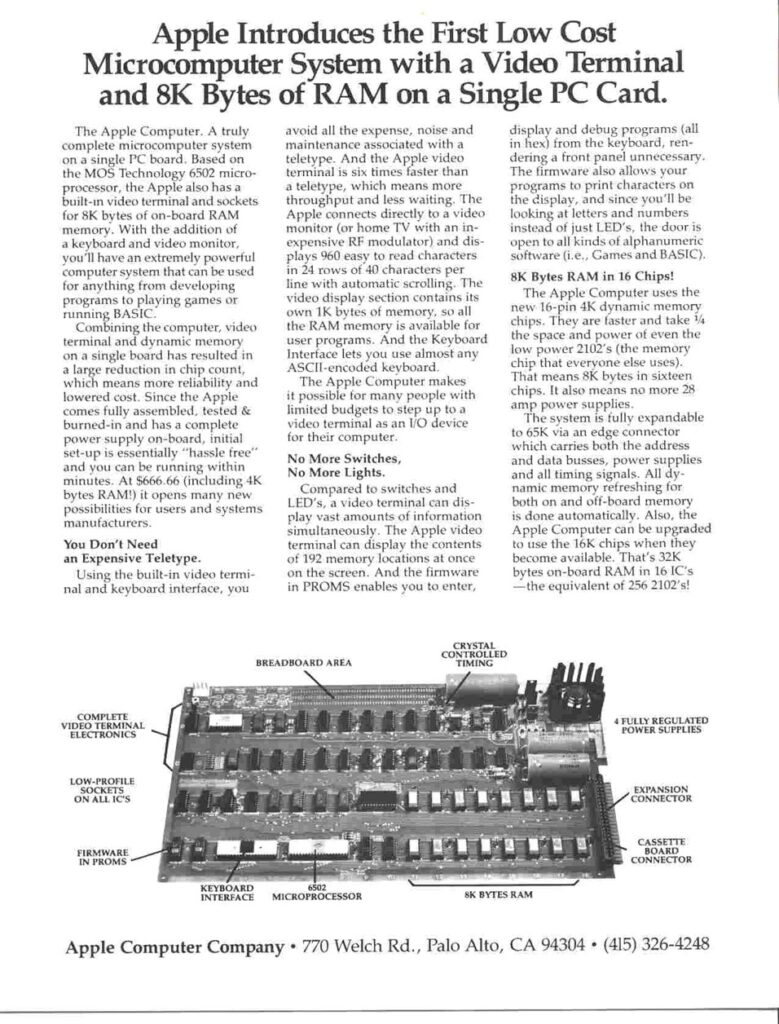About the Apple 1, and modern clones I have like the A-ONE and the Replica 1.
All of us older computer geeks know that before selling Macs, Apple founders Steve Wozniak (the genius) and Steve Jobs (the greedy business man) had a lot of success with the Apple ][ or Apple 2 or Apple ii, whatever marketing tricks were done with the name of that remarkable personal computer. The 2 in the name suggest there was an Apple 1 and yes, there were a very limited numbers of boards sold (200 or so, 50 or so survived time, so its a valuable collectible) branded Apple 1 in the 1976-77 time-frame. It has video on board and accepts input from a full size keyboard, so it is one of the first standalone hobby/personal computers based on a microprocessor, the 6502 of course, being powerful and cheap at that moment.
What is an Apple 1?
Besides being the first product of Apple Computers and designed by Steve Wozniak, the Apple 1 featured as one of the first a complete computer, with keyboard and video, on one board, based on an affordable and powerful microprocessor, the 6502.

Apple 1 Replica
There are several Apple 1 clones made! The Replica-1 SE by Vince Briel was the first to apply modern components to replace the hard to get and therefore expensive components, like the Signetics 2513 and such, with modern microprocessors emulating the terminal part. The terminal part is replaced by three microcontrollers, for video and serial interface. Before he made the Micro-KIM, Vince Briel designed quite a complex replica of the Apple 1. Complex because of the now defunct, hard to get components. He worked around that problem beautifully with innovative modern solutions and added conventient modern connections like USB and PS/2 keyboard. The result is the Apple 1 Replica (SE). Available are a slot expansion for three real Apple 1 slots, a multi-I/O board with ACIA 6551 and 6522 VIA and, via Rich Dreher, the CFFAA1 (Compactflash mass memory) board.
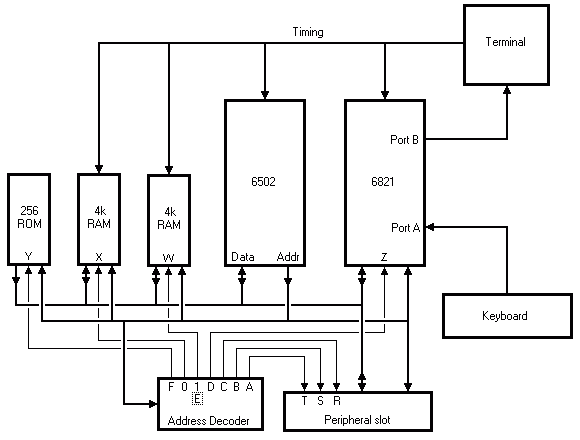
Here a collection of pages on Replica 1 designs.
Of these Replica’s I have in my collection the Replica 1 SE and the A-ONE extended. Both excellent computers wit some differences:
- The A-ONE is even more compact, less IC’s.
- The A-ONE has a real Apple 1 slot instead of the pin header on the Replica-1 but in shrinken format!
- No parallel keyboard interface on the A-ONE, the PS/2 input functions as the keyboard. On the Replica both parallel and PS/2 can be used.
- Selection of NTSC or PAL on the A-ONE delivers a rock solid picture.
- The Replica-1 has USB, also functioning as power supply, as an option also as serial interface.
- The Replica-1 has an AT(X) power connector, required for the -12V of the parallel Apple keyboard.
- The Replica 1 has a EEPROM, the A-ONE an oldfashioned EPROM.
- The forum of Briel Computers for the Replica-1 gives good support for the community.
- The Replica 1 is still available for sale as Plus
- The CFFA1 card delivers mass storage to the Apple 1 but the A-ONE is connector is not the right size.
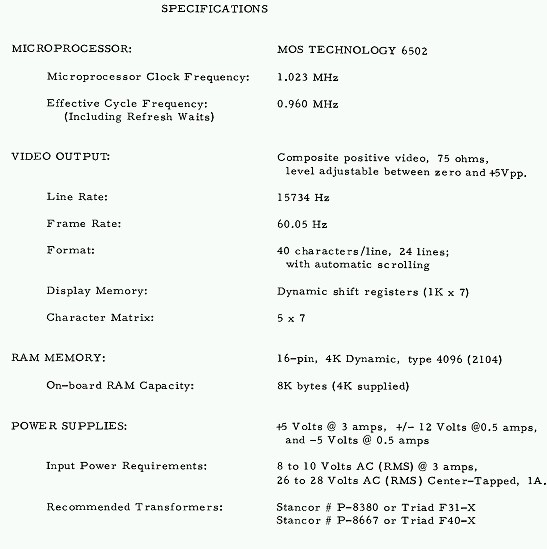
(Specifications from from the original manual)
In fact the Apple 1 is made up of:
- A 6502 based microprocessor system with 4K RAM (dynamic ICs) and 256 bytes ROM
- A ‘monitor’ program called WOZmon (written by Steve Wozniak, in those 256 bytes!)
- A video terminal, made with dynamic shift registers, a uppercase only character generator (the famous Signetics 2513)
- Connector for parallel ASCII keyboard
The microprocessor and he terminal part are glued together via a PIA 6821. One 8 bit parallel port reads the ASCII keyboard, the other port delivers the characters to be displayed on the video terminal.
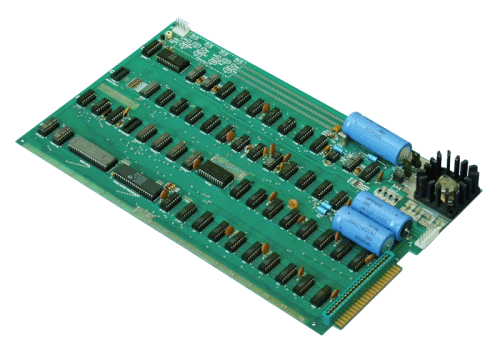
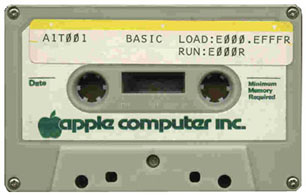
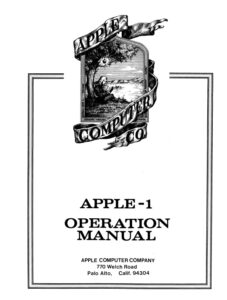 |
APPLE I_Operation Manual |
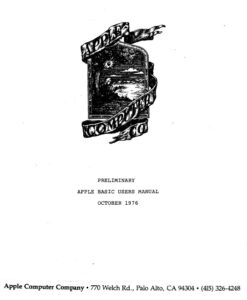 |
Apple 1 Basic Manual |
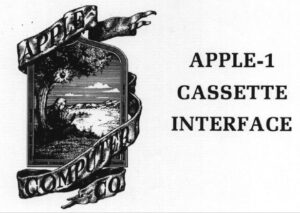 |
Apple 1 Cassette Interface manual |
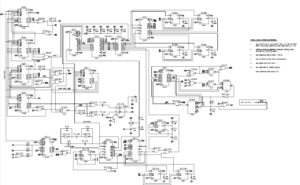 |
Redrawn Apple 1 circuit diagram |
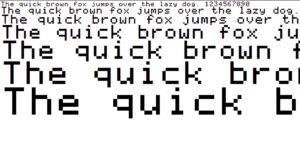 |
Truetype Apple 1 (2513 IC) font |
Software
An archive with my collection of Apple 1 software, hex files, bin files, sources, extended monitor, games, utilities, assembler. See also the Replica 1 and A-ONE pages for more software.
Datasheets of the now rare Signetics ICs in the Apple 1 (available on every Apple 1 page, but they are all the same documents scanned by me, Hans Otten!)
Apple 1 monitor
The Apple 1 comes with the WOZ monitor. A very small but smart program, since there is only 256 byte available in the PROM of the original.
It can do just the basic:
1. The prompt is ‘@’
2. Enter one or two hex numbers, separated by a dot, and it shows you the content of memory from first to last number
3. Enter a hex number to be put in memory, by specifying the address, a ‘:’ and then the hex number for that memory location. Or as many bytes for consecutive locations.
4. Run a program from a memory location.
The monitor is so simple, smart enough to be usable for the replica’s. Via the serial interface you can dump standard hex files to the Apple 1!
The API of the Apple 1 is not much more than:
1. read a character from the keyboard
2. Read a line form the keyboard
3. Write a character on screen
4. Write a hex string to the screen
When the optional cassette interface is added, some more command are added to read and write data from and to an audio cassette tape recorder. Be warned, the Apple 1 cassette interface is very strict about the quality of the tape and the qualiy of the power supply! With other words, its a disaster to work with.
Apple 1 Basic
Steve Wozniak wrote, by hand, no assembler used, a Basic interpreter for the Apple 1, fitting in 4K. No floating point, a pre-runner of Integer Basic for the Apple 1.
Good enough to run simple Basic programs, 4K is not much memory. Mostly text based games. Some are still available.
Krusader and A1 Assembler
Ken Wessen has produced an assembler, disassembler and debugger and even added a small powerful machine monitor . The program is called Krusader and it fits in 4K. Built in in the Apple 1 Replica and the A-ONE.
Visit the Replica 1 software page where also a working version of the Apple 1 emulator POM-1 can be found.
San Bergmans produced also an assembler package for the Apple 1, called A1 Assembler. A small sister or subset of his impressive SB-Assember. More powerful than the Krusader assembler, but no debugger. Can be used on any Apple 1 replica and is built in in the A-ONE.
You can find a large collection of Apple 1 software in the githib archive of Jeff Trantor.
Programming languages
Ports of Lee Davison’s excellent 6502 Basic, and Figforth are available. For these you will need the A-ONE or Replica since these have 32K RAM to play with.
Cross assembling/compiling
Any 6502 assembler on another platform that can produce hex files can be used to develop programs on the Apple 1. Dont worry about the Apple 1 API, since there is nearly nothing …
The CC65 package, a C compiler and assembler for the 6502, can also be used with the Apple 1 CC65 patches

